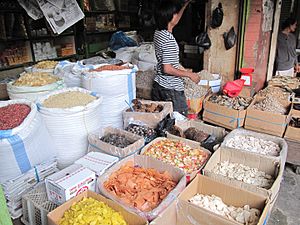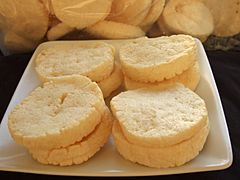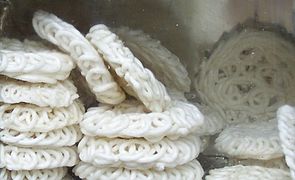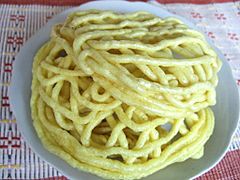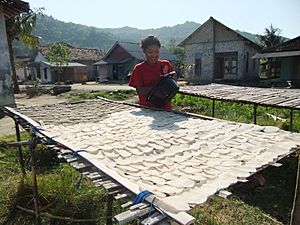Krupuk facts for kids
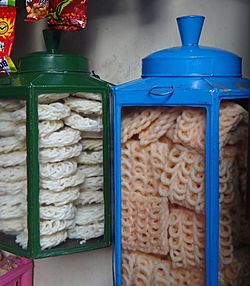
Kerupuk in air-tight tin containers
|
|
| Alternative names | Kerupuk, keropok |
|---|---|
| Course | Snack |
| Place of origin | Indonesia |
| Region or state | Java |
| Serving temperature | Room temperature |
| Main ingredients | Starch, animal proteins, vegetables. |
| Variations | Different variations according to ingredients |
Krupuk is a crunchy cracker popular in Southeast Asia. It's made from starch or animal skin, with different ingredients added for flavor. Most krupuk is deep fried, but some types can be grilled or fried in hot sand.
This tasty snack is very common in countries like Indonesia, Singapore, Malaysia, Brunei, and the Philippines. It's especially famous in Indonesian cuisine, particularly in Javanese cuisine. Krupuk is a staple food in Indonesia and has spread to other countries through people traveling or through exports.
Contents
What's in a Name?
The word Krupuk comes from the Javanese language. It means "fried side dish" and is usually made from flour mixed with other ingredients. This word was later used in other languages, changing slightly in pronunciation.
- In Indonesia, it's called "kerupuk".
- In Malay, it's "keropok".
- In Dutch, it's "kroepoek" (where "oe" sounds like "u").
The sound of crunchy foods, like krauk (for a big crunch) or kriuk (for a small crunch), might have inspired the name. This sound also likely inspired the name of kripik, which is another type of Javanese cracker.
A Snack with a Long History
Historians believe that krupuk has been around in Java since the 9th or 10th century. Old writings from that time, like the Batu Pura Inscription, mention krupuk rambak. This was a cracker made from cow or buffalo skin. You can still find these skin crackers today, called krupuk kulit. They are often used in a Javanese dish called krechek.
Over time, krupuk spread across the archipelago (the islands of Southeast Asia). Its taste changed depending on the local ingredients. From Java, krupuk traveled to coastal areas like Kalimantan, Sumatra, and the Malay Peninsula. Today, it's a key part of the food traditions in several Southeast Asian countries. You can even find kroepoek in the Netherlands because of their past connections with Indonesia.
Now, krupuk is an important food product that Indonesia exports to many countries. These include Thailand, China, South Korea, the United States, Mexico, and even countries in the European Union.
How to Make and Eat Krupuk
To get krupuk super crunchy, most raw, pre-packed krupuk needs to be sun-dried first. After drying, it's usually deep fried in a wok with lots of hot cooking oil.
For a healthier option, you can cook raw krupuk in a microwave oven. Just one minute at medium power (around 700W) is usually enough to puff up a handful of chips. Raw krupuk is quite small, hard, and darker than the cooked version.
You can enjoy krupuk in a few ways:
- Eat it by itself as a simple snack.
- Break it into pieces and sprinkle it on top of other foods. This adds a nice, crispy texture.
- Some Indonesian dishes like gado-gado, karedok, rujak, asinan, bubur ayam, and certain kinds of soto use specific types of krupuk as toppings.
- It's also a main ingredient in seblak, a spicy dish where boiled krupuk is cooked with protein and a hot sauce.
Different Kinds of Krupuk
Indonesia has probably the biggest variety of krupuk. Many types are made from starch mixed with seafood like shrimp, fish, or squid. But you can also find variations made with rice, fruits, nuts, or vegetables.
- Krupuk amplang: These are fish krupuk, about the size of a ping-pong ball, from Kalimantan.
- Krupuk bawang: A cracker flavored with garlic.
- Krupuk gendar: A cracker made from ground rice.
- Krupuk ikan: Fish crackers are common in Indonesia, especially in places known for seafood, like Palembang and Sidoarjo. Wahoo fish is often used, but some more expensive versions use belida fish.
- Krupuk blek (also called krupuk uyel, krupuk kampung, or krupuk putih): This is a very common cracker in Indonesia, made from cassava starch.
- Krupuk kemplang: A flat type of fish cracker, very popular in Palembang, South Sumatra.
- Krupuk kuku macan: Another name for amplang. These are brown, nugget-shaped fish crackers, often linked to Samarinda and Bangka Island.
- Krupuk kulit: Found in most parts of Indonesia, also known as Krupuk jangek (Minangkabau) or Rambak (Java). These crackers are made from dried cattle skin and are very popular in the Minangkabau area of West Sumatra.
- Krupuk kulit babi: Crispy fried pork skin, also known as pork rinds. You won't find these much in Muslim-majority areas of Indonesia, but they are common in places like Bali and North Sumatra.
- Krupuk mie (noodle cracker): A yellowish krupuk made from a noodle-like paste. It's often used as a topping for asinan and is popular in Jakarta and other markets in Java.
- Krupuk udang: Shrimp or prawn crackers are probably the most famous type of krupuk around the world. Popular brands in Indonesia include Resep Kerupuk Udang and Finna.
-
Krupuk udang, prawn cracker
-
Krupuk ikan, fish cracker
-
Krupuk amplang, fish cracker
-
Krupuk kemplang, fish cracker
-
Krupuk kulit, skin cracker
Krupuk in Malaysia
In Malaysia, krupuk is called keropok. This name is usually used for crackers made with fish and seafood. If they are made with other foods, they are called kerepek.
Some types of keropok found in Malaysia include:
- Keropok kering
- Keropok lekor
- Amplang
Keropok lekor first came from Terengganu. Amplang is special to the coastal towns of Semporna and Tawau in Sabah. Keropok kering can be found in most parts of Malaysia. The town of Mukah in Sarawak is also known for making keropok because it's a fishing town.
Krupuk in the Philippines
In the Philippines, krupuk is usually spelled kropek or kropeck. People sometimes call them "fish crackers," "prawn crackers," or "fish chicharrón" (which is technically fried fish skin). Some types of chicharrón are made from plants, like tapioca starch and green peas.
Kropek is often eaten as an appetizer (a snack before a meal). It's usually served with a dipping sauce made of vinegar and chili. People also enjoy it with drinks or as a side dish with a meal. Many local brands in the Philippines sell different kinds of kropek. Some well-known brands are La La Fish Crackers and Oishi prawn crackers. Oishi is a big company from the Philippines that has grown across Asia.
Where Krupuk is Made
In Indonesia, many krupuk are made in coastal fishing towns. Places like Sidoarjo in East Java, Cirebon in West Java, Karimun Jawa island, Padang, Palembang, and Medan in Sumatra are big producers. Bangka Island, Samarinda, Pontianak in Kalimantan, and Makassar in Sulawesi are also major krupuk makers. Many krupuk recipes come from these areas.
Some towns away from the coast are also famous for making krupuk, such as Bandung, Garut, and Malang. These towns usually don't make seafood-based krupuk like the coastal towns do. Most krupuk producers traditionally are small, family-run businesses. Today, krupuk factories face a challenge: should they use modern machines to make more krupuk but possibly have to let go of some workers, or keep making it the traditional way but produce less?
In Malaysia, most coastal towns like Mukah, Malacca Town, Pangkor Island, and Lumut produce keropok. This ranges from large factories to small home-based businesses.
See also
 In Spanish: Keropok para niños
In Spanish: Keropok para niños


